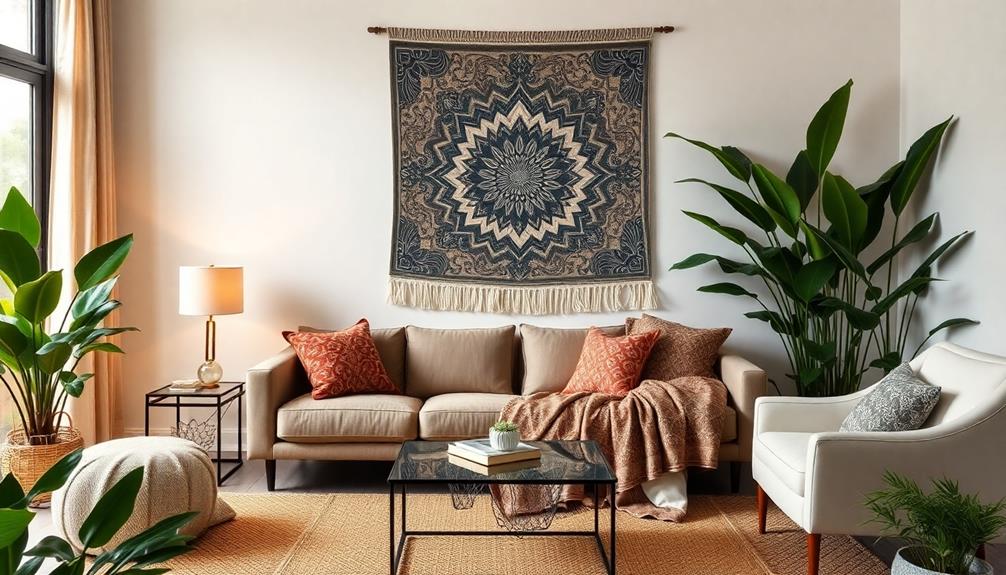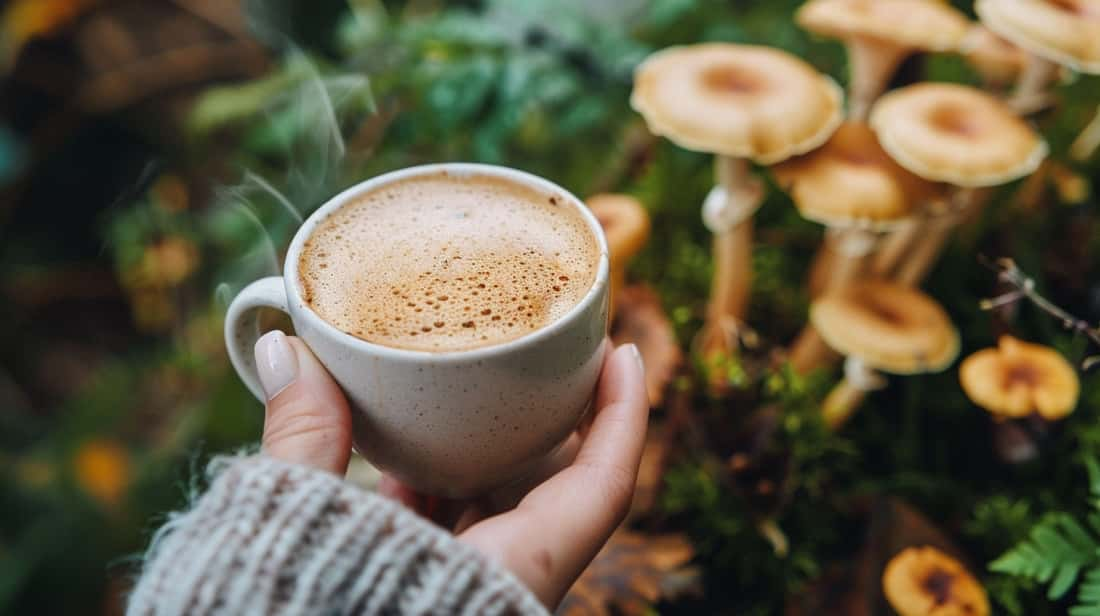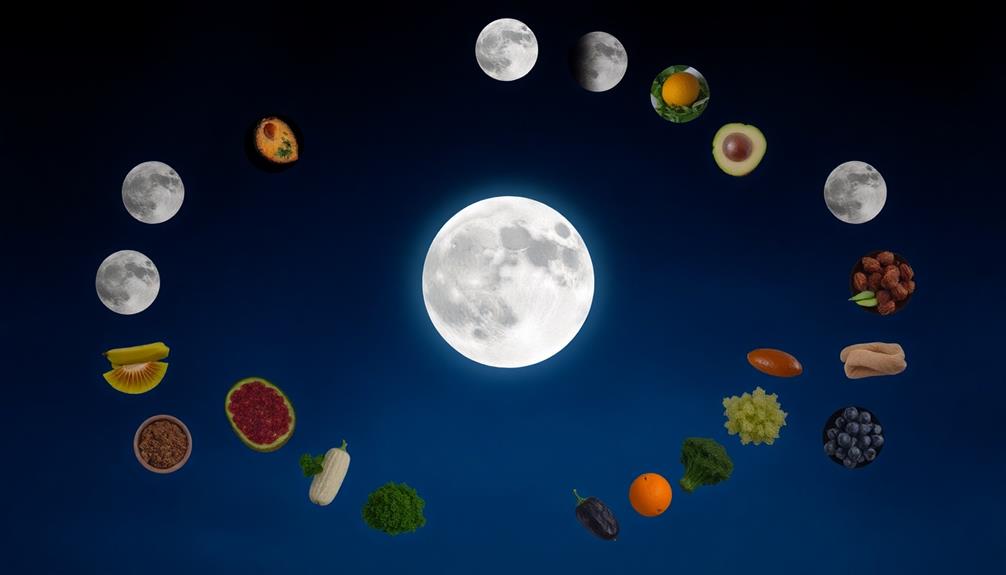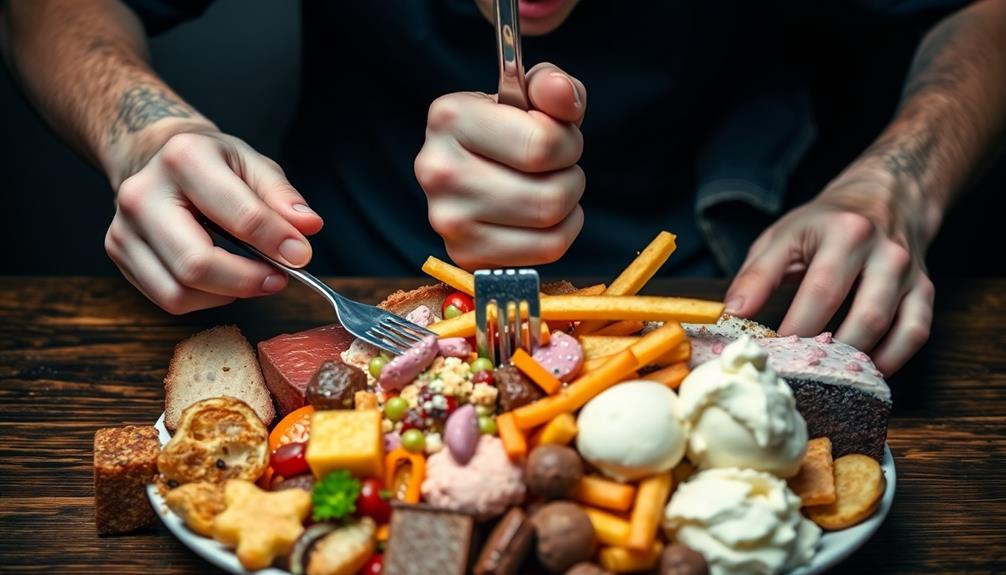Batik plays an essential role in interior design, adding vibrant colors and unique patterns that elevate your space. These textiles, rich in cultural significance, reflect artisanal craftsmanship and storytelling. You can use batik in upholstery, decorative pillows, or as wall art, blending seamlessly with various styles from modern to traditional. Mix batik with solid colors to create visual balance and highlight its intricate designs. Whether you're aiming for coziness or sophistication, batik's versatility enhances your home's aesthetic. If you're curious about more ways to incorporate this beautiful fabric into your decor, there's plenty more to explore.
Key Takeaways
- Batik fabrics add vibrant colors and intricate patterns, enhancing the aesthetic appeal of stylish interiors.
- The wax-resist dyeing technique preserves cultural narratives, making batik a unique decorative element.
- Versatile applications include upholstery, cushions, curtains, and wall art, allowing for diverse design integration.
- Mixing batik with solid colors promotes visual balance and complements various decor styles.
- Batik's historical significance and artisanal craftsmanship elevate interior spaces, connecting them to rich cultural heritage.
Understanding Batik Fabric
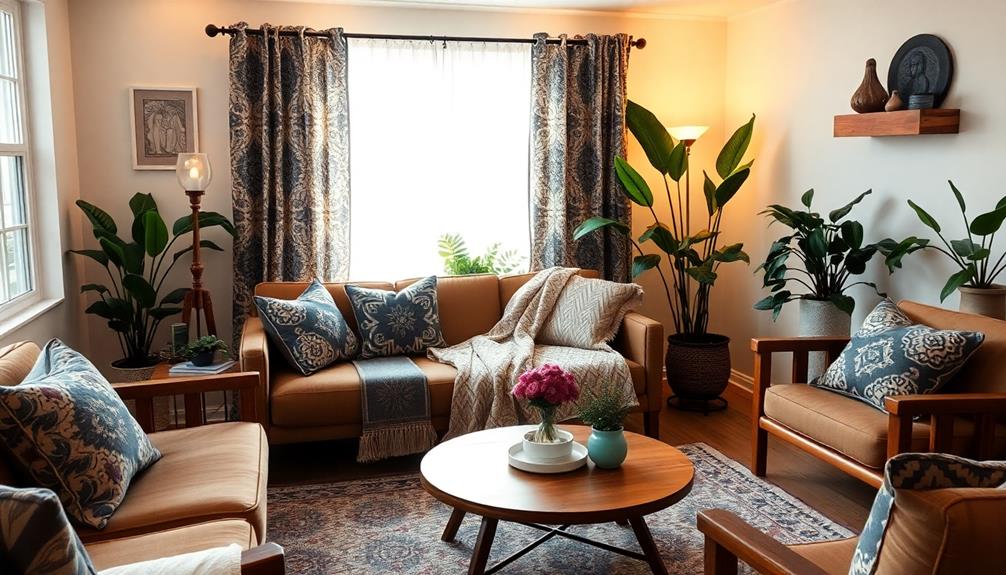
When you explore batik fabric, you'll discover its rich history and intricate artistry deeply rooted in Indonesian culture. Originating from the Javanese word "ambatik," which means a cloth with little dots, batik is created through a wax-resist dyeing process. This method preserves certain areas of the fabric in their original color, allowing for the unique patterns that define traditional batik.
Additionally, the vibrant artistry of Indonesian decor masks complements batik beautifully, enhancing the cultural narrative of your home.
You'll encounter various styles, including Batik Tulis, which is hand-drawn, and Batik Cap, which is stamped. Each showcases distinct motifs inspired by nature, mythology, and cultural narratives, reflecting the vibrant stories of Indonesia. The meticulous craftsmanship involved speaks volumes about the dedication and skill passed down through generations.
Batik fabric isn't just about aesthetics; it serves practical purposes too. You can incorporate it into your home decor through pillows, throws, curtains, and upholstery, adding a layer of cultural richness and artistic appeal to your living space.
Historical Significance of Batik
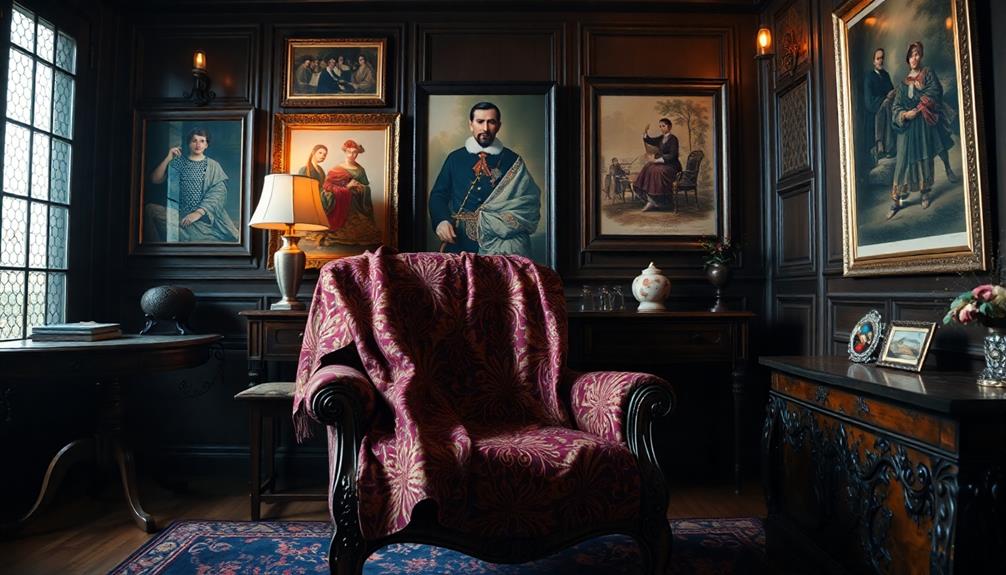
Batik has woven its way through Indonesian history, showcasing its significance as more than just a textile art form. With roots dating back to the 6th century, this craft reflects the cultural heritage and diverse identities of Indonesian communities. Recognized by UNESCO in 2009, batik embodies intricate patterns that represent community stories and spiritual beliefs.
Historically, batik was a mark of social status, worn primarily by royalty and aristocracy. Its designs often carry deeper meanings, making it essential in cultural rituals and ceremonies. As you explore the historical significance of batik, you'll discover how its labor-intensive wax-resist dyeing technique varies regionally, influenced by local folklore and nature.
| Aspect | Details |
|---|---|
| Origin | Dates back to the 6th century |
| Cultural Recognition | UNESCO Masterpiece of Intangible Heritage |
| Social Status | Initially worn by royalty and aristocracy |
| Symbolism | Represents community stories and beliefs |
Techniques and Processes
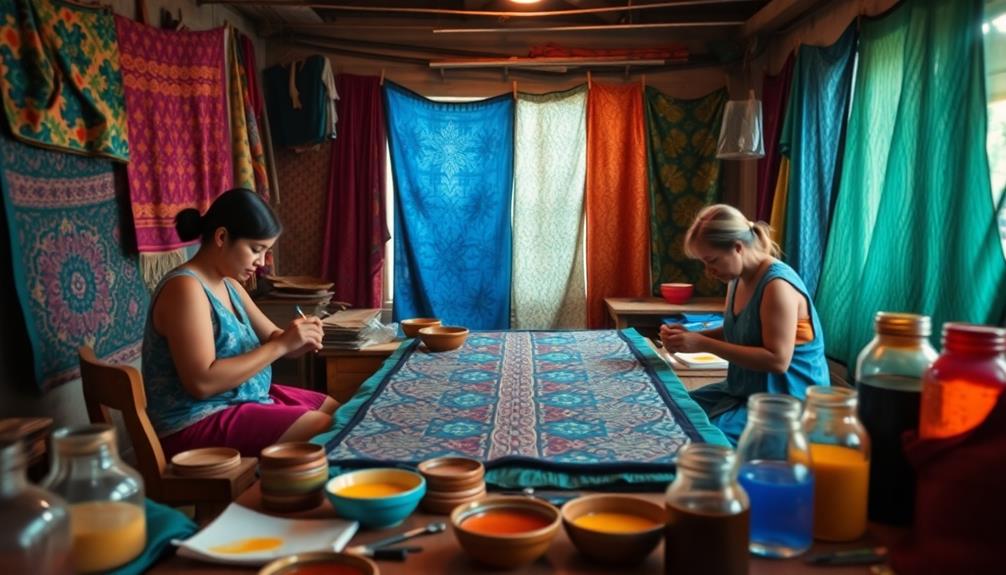
The art of batik involves a fascinating wax-resist dyeing technique that brings fabric to life with intricate designs. This method begins with applying hot wax to the fabric, creating patterns that will resist dye.
You'll find two primary types of batik techniques: Batik Tulis, which is hand-drawn and labor-intensive, and Batik Cap, where artisans use copper stamps for quicker production. Batik is often used in making Indonesian decorative pillows, adding a touch of cultural heritage and vibrancy to living spaces.
The traditional process includes several steps. First, you prepare the fabric, then apply the wax using a tjanting tool or stamps. After that, the fabric is dyed using natural dyes derived from plants and minerals, which contribute to its vibrant colors and eco-friendly appeal.
Finally, you remove the wax to reveal the stunning batik designs beneath. The complexity of traditional motifs can vary greatly, with more intricate designs requiring additional time and skill, making them highly sought after.
Whether you're drawn to bold patterns or delicate details, understanding these techniques enhances your appreciation of batik and its role in interior design. Each piece tells a story, connecting you to the rich cultural heritage behind these beautiful fabrics.
Batik in Modern Interior Design

Incorporating batik in modern interior design adds a vibrant touch that can transform your space. Batik fabrics, with their rich patterns and colors, breathe life into contemporary settings, making them a favorite among craft enthusiasts and designers alike.
This integration is reminiscent of traditional Indonesian style home decor, where intricate textiles play a vital role in enhancing the aesthetic appeal of a space. You can use batik to create striking accent pieces like cushions, throws, and curtains, introducing a cultural richness that complements various styles without overwhelming the overall design.
Modern interpretations of batik often feature bold colors and abstract designs, perfect for creating eye-catching focal points in your living room or bedroom. This versatility allows you to layer textures and colors seamlessly, whether your aesthetic leans towards bohemian, eclectic, or even minimalist.
Moreover, the trend of incorporating batik into modern interiors reflects a growing appreciation for artisanal craftsmanship and cultural heritage. By choosing batik fabrics, you're not only enhancing your decor but also supporting sustainable and ethically-produced textiles.
As you explore the world of batik, you'll discover how these unique pieces can elevate your home, making it a stylish and meaningful reflection of your personal taste.
Color and Pattern Selection
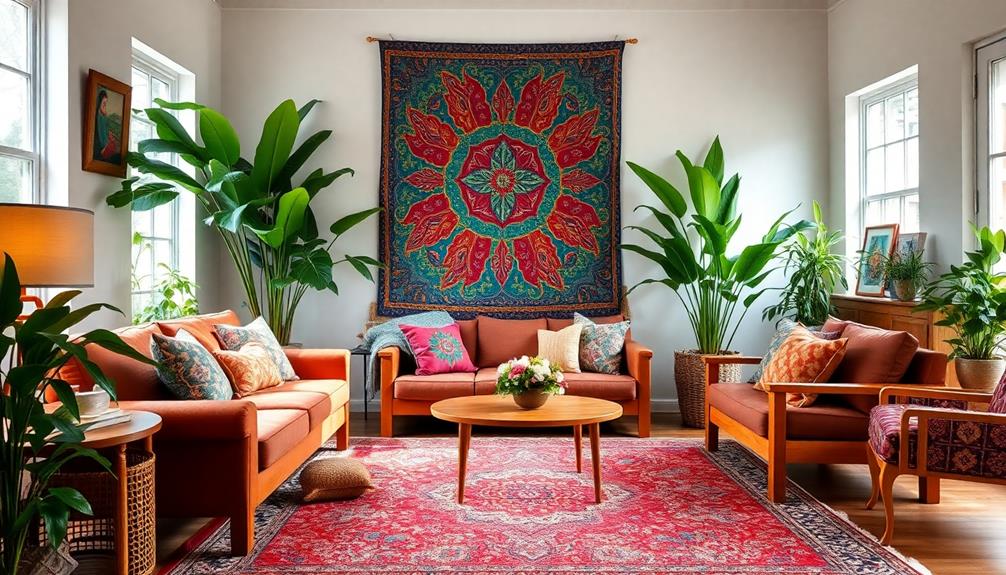
How do you choose the right colors and patterns in batik to enhance your interior space? Start by considering the mood you want to create. Warm tones in batik fabrics can make a room feel cozy, while cooler hues promote tranquility.
Additionally, incorporating elements from the rich tradition of Indonesian decor masks can complement the vibrant batik patterns beautifully. Next, look at the batik patterns that resonate with you; many draw inspiration from nature and folklore, adding depth and cultural storytelling to your decor.
When it comes to color and pattern selection, think about how these elements will complement your existing interior design. Mixing batik with solid colors can strike a perfect balance, preventing visual clutter.
The versatility of batik allows it to fit into various design styles, whether you prefer a modern bohemian vibe or a more traditional look.
Using batik in smaller doses can also be effective. Consider incorporating it through cushions or wall art, allowing you to express stylish patterns and colors without overwhelming the space.
Practical Applications in Decor
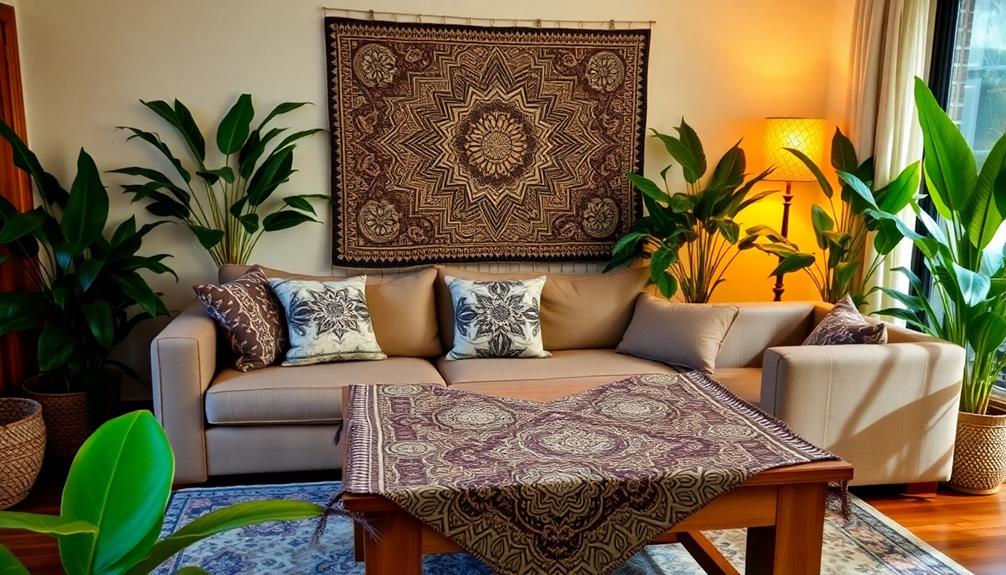
Batik fabric offers countless practical applications in decor, allowing you to infuse your space with vibrant colors and intricate patterns. One of the most elegant uses is as upholstery for furniture. By choosing batik for your chairs or sofas, you add character and warmth that instantly elevate your living space.
Additionally, incorporating elements like Indonesian decor masks can further enhance the cultural richness of your home, as they represent a deep cultural heritage that adds depth to your decor.
You can also create stunning decorative pillows and throws from batik fabric. These accents enhance visual appeal and provide texture, perfect for accentuating seating areas or beds.
For a striking focal point, consider wall-mounted batik panels or tapestries. They showcase traditional craftsmanship while integrating cultural narratives into modern decor.
In the dining area, batik table runners and napkins can transform your gatherings. They infuse sophistication and a touch of global charm, making every meal a special occasion.
Ultimately, incorporating batik into curtains or drapes allows for playful light filtering, enhancing the overall ambiance and visual interest in your room.
Global Influence on Design Trends

The influence of batik on global design trends is undeniable, as its vibrant patterns and rich history have captivated designers and homeowners alike. Batik artists have skillfully blended traditional techniques with modern influences, creating textiles that resonate with a wide audience.
This dynamic interplay not only showcases the cultural significance of batik but also elevates interior spaces across the world. Additionally, the use of natural materials and earth tones in batik textiles aligns beautifully with Balinese design characteristics, enhancing the overall aesthetic of spaces they inhabit.
Here are three ways batik influences modern design:
- Versatility in Use: Batik can be seamlessly incorporated into various decor elements, from upholstery to wall art, allowing you to express your personal style while honoring its heritage.
- Sustainable Choices: The rise of eco-conscious design has spotlighted sustainable batik products, often made using natural dyes and labor-intensive methods, appealing to environmentally-minded consumers.
- Fashion Crossover: Global fashion designers, like Diane von Furstenberg, have embraced batik, promoting its use in home decor, which bridges the gap between fashion and interior design.
Creating a Harmonious Space With Batik

Creating a Harmonious Space With Batik
Incorporating batik into your interior design can transform a space, infusing it with vibrant colors and intricate patterns that capture attention. Using batik textiles like cushions, throws, and curtains adds a unique flair while creating a focal point that enhances your room's aesthetic appeal.
The versatility of batik allows it to blend seamlessly with various design styles, from traditional to modern, making it an ideal choice for accent pieces that promote harmony with your existing decor. For those seeking a luxurious tropical design aesthetic, Mahallati Interiors offers custom solutions that beautifully integrate batik elements into serene spaces.
To maintain a harmonious atmosphere, consider mixing batik patterns with solid colors or minimalist designs. This approach guarantees that the vibrant motifs complement rather than overwhelm your overall decor scheme.
Additionally, utilizing batik in upholstery or wall art introduces a touch of global charm, promoting diversity and appreciation for traditional craftsmanship.
The cultural significance and storytelling embedded in batik designs can evoke warmth and individuality, fostering a deeper connection between you and your environment.
Frequently Asked Questions
What Is the Significance of Batik Design?
Batik design's significance lies in its rich cultural narratives and intricate craftsmanship. Each pattern tells a story, reflecting local traditions and beliefs, allowing you to connect with heritage while adding unique beauty to your space.
What Are the Elements and Characteristics of Batik?
Batik's elements include intricate patterns, vibrant colors, and cultural motifs. You'll notice the unique wax-resist dyeing technique, which protects certain areas from dye, creating beautiful designs that reflect local stories and traditions.
What Are the Two Main Types of Batik Art?
Batik art's like a tapestry of culture, showcasing two main types: Batik Tulis, hand-drawn and intricate, and Batik Cap, stamped for efficiency. Each tells a unique story through its distinct patterns and techniques.
What Do You Need to Know About Batik?
You need to know that batik's a traditional Indonesian textile art, featuring intricate patterns created through a wax-resist dyeing technique. Its rich cultural history and diverse styles make it a unique and meaningful art form.
Conclusion
Incorporating batik into your home isn't just about decoration; it's about storytelling. This vibrant fabric weaves history and culture into your space, transforming it into a stylish sanctuary. Imagine the rich patterns and colors enlivening your rooms, inviting warmth and character. So, why not embrace the beauty of batik and let your walls speak volumes? With just a few thoughtful pieces, you can create a harmonious atmosphere that feels uniquely yours—where every corner tells a tale.
